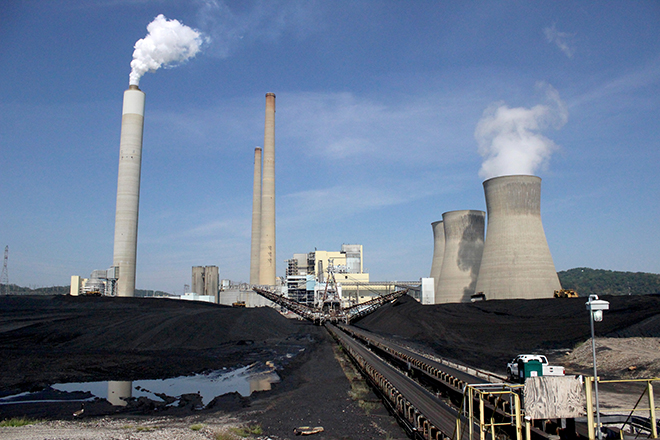S&P Global Offerings
Featured Topics
Featured Products
Events
S&P Global Offerings
Featured Topics
Featured Products
Events
S&P Global Offerings
Featured Topics
Featured Products
Events
Banking & Capital Markets
Economy & Finance
Energy Transition & Sustainability
Technology & Innovation
Podcasts & Newsletters
Banking & Capital Markets
Economy & Finance
Energy Transition & Sustainability
Technology & Innovation
Podcasts & Newsletters
S&P Global Offerings
Featured Topics
Featured Products
Events
20 Oct, 2021
By Karin Rives

| AEP's John Amos coal-fired power plant in West Virginia will remain open until at least 2040 after state regulators in October 2021 approved millions in upgrades to this and two other coal plants. Source: S&P Global Market Intelligence |
Climate Action 100+, a leading coalition of five investor groups with $60 trillion in assets, is adding pressure on the world's leading utilities — including Duke Energy Corp., Dominion Energy Inc., Southern Co. and American Electric Power Co. Inc. — to decarbonize by 2035 in line with the Paris Agreement on climate change.
The Oct. 20 investor appeal means that, if heeded, all but a few of the 30 largest power companies in the U.S. would need to move up their net-zero emission goal by 15 years. The International Energy Agency said earlier this year that utilities in advanced economies must move away from all fossil fuels by 2035 and developing nations must do so by 2040 to meet the Paris treaty's goal of limiting global warming to 1.5 degrees C above preindustrial levels.
In a June survey, S&P Global Market Intelligence found that only two of the 30 largest U.S. utilities by market capitalization had announced they would reach the 2035 goal, which the Biden administration has also endorsed.
The Climate Action 100+ coalition uses what it calls a net-zero company benchmark to guide investors on where to place their money and how to engage with companies in which they hold shares. The 2035 decarbonization target is expected to be included in that benchmark.
Dan Bakal, senior director of climate and energy for the group Ceres, a coalition member, said some investors will likely continue to base their investments on utilities' existing strategies and goals for reducing greenhouse gases.
"Many others will use the [benchmark] to engage directly with companies and urge them to align with the goal of decarbonizing by 2035," Bakal said.
Power must remain "reliable and affordable"
In its report for investors, the coalition highlighted AEP as a case study of the challenges utilities face in quickly switching away from fossil fuels. Historically a coal-heavy utility, AEP has already reduced carbon emissions by 74% since 2000, in part because it generates less electricity.
However, with coal plants still making up 45% of the company's generation and natural gas plants another 28%, AEP's carbon intensity remains high, and the utility has said it will not be able to fully transition to clean energy before 2050.
AEP spokesperson Tammy Ridout acknowledged in an email that the company's customers, investors and other stakeholders expect AEP to move as quickly as possible to a clean energy future.
"We are pursuing that goal," Ridout said, adding that "it's critical to our customers and the economy that we make the clean energy transition in a way that ensures electricity remains reliable and affordable."
The company is working with policymakers and other parties to push for policies that will accelerate the deployment of renewable energy sources and technology development that can help speed the transition, Ridout said.
The four-year-old Climate Action 100+ coalition consists of the Asia Investor Group on Climate Change, Ceres, Investor Group on Climate Change, Institutional Investors Group on Climate Change and Principles for Responsible Investment — groups that span interests across the world. Together they prod and push 167 companies from 15 economic sectors that were deemed to be "key to the energy transition" because of their size or carbon footprint.
